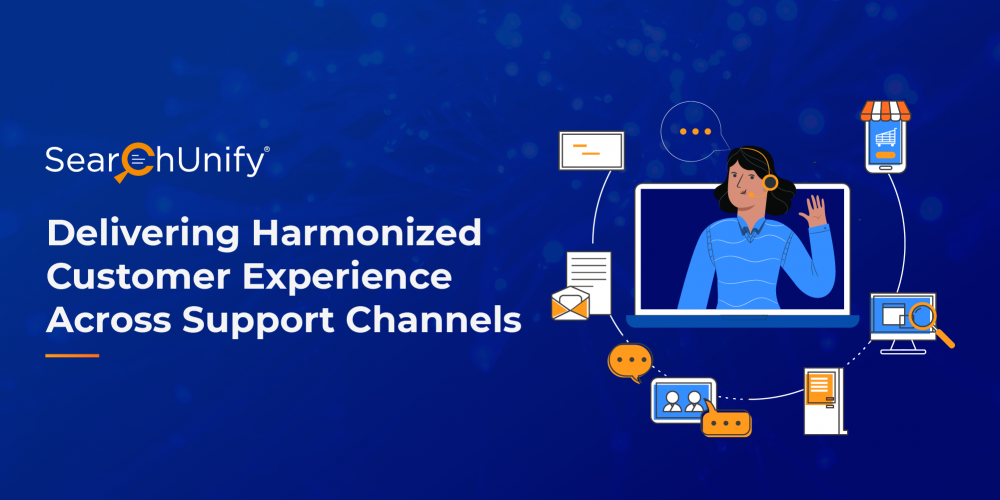
More channels aren’t always equivalent to more value for customers. In fact, customers no longer care about the number of channels being offered to them. All they want is a consistent, seamless, and personalized customer experience, irrespective of the support channel. It’s imperative to orchestrate the CX experience in a way that ensures the context and history of customers move with them each time they switch from one channel to another. It all boils down to harmonizing channel experiences and creating customer connections by proactively responding to their queries and providing consistent support.
Customer service leaders are working to provide both proactive and productive support to users. Proactive support to douse the flames before things go out of control; productive support so that they effectively and efficiently answer every query. However, what they’re overlooking is how well these channels work in conjunction. Because, when not in sync, switching between channels can be a service nightmare.
According to this linkedin post, customers report having to repeat information 50% of the time they interact with companies—much of that is the result of this channel-switching behavior. And, repetition is a killer: it increases effort by an astounding 60%.
How can we ensure a cohesive and personalized experience for customers regardless of the channel? One sure-fire way to quash all these challenges is by integrating a enterprise agentic platform to your support organization.Doing so, will have you jumping through hoops to enrich customer and employee experiences so that you can expedite workflows and improve outcomes. If you’re wondering how, then this blog post is for you. It will acquaint you with the role that cognitive technology plays in turning your omni-channel experience up to eleven.
The Role of Cognitive Technology in Building a Seamless Cross-Channel Experience
When debating multichannel vs omnichannel vs optichannel, one key area you want to keep in focus is the customer experience across channels. When the various channels are not in sync, toggling between them can be a service nightmare. This is how cognitive technology helps:
1. Amalgamate Multi-Channel Support with a Enterprise Agentic Platform
90% of customers expect consistent interactions across channels. Now, imagine their frustration each time they have to repeat themselves just because they shifted to a different channel. This is where the need to integrate all the touchpoints used by customers and support agents becomes apparent.
A enterprise agentic platform like SearchUnify can certainly help you fill these gaping holes. Furthermore, use its analytics to glean actionable insights into any roadblocks your users might encounter while switching between channels, thereby highlighting areas of improvement.
2. Gain a Panoramic View of Every Customer Journey
Every user interaction is a goldmine of data. Leverage AI to take into account customer history, preferred medium of communication, browsing history, customer sentiments, etc. and gain a 360-degree view of the customer’s journey. When this data is converted into actionable insights, contact centers can use it to deliver the right service at the right time, whatever the channel.
According to Gartner, fewer than 10% of companies have a 360-degree view of their customers, and only 5% are able to use a 360-degree view to systemically grow their businesses.
3. Equip Agents to Resolve Queries Faster
Agents need quick and relevant information to solve customer queries in a timely manner. But, since information resides in disparate sources, agents often waste their time in platform-hopping to find relevant information.
SearchUnify’s enterprise agentic platform integrates all the disparate content sources within an agent’s console and helps to get rid of the swivel-chair effect. Consequently, agents get instant access to information regardless of where it resides, thus augmenting AX, CSAT, and AHT. Additionally, with an app like Agent Helper, your support reps are equipped with relevant & personalized solutions, thus enabling them to cut through all the noise to quickly and effectively close tickets.
4. Play Catch, Not Ping Pong
Intelligent swarming systems enable streamlined workflows and empower agents to perform at their peak operational efficiency. SearchUnify’s Escalation Predictor analyzes a multitude of things, like the existing case data to tell-tale signs of escalations by predicting user sentiments or gauging dissatisfaction. It intelligently triages incoming tickets based on priority to the most suitable agent with the required expertise, right off the bat. This eventuates in feeding multiple birds with one scone where MTTR and AHT take a dip whereas FCR, CX, and CSAT soar high.
5. Provide Proactive Support
A little foresight to anticipate customer issues and personalize your services can go a long way to ensure the success of your support organization. AI-driven technology analyzes user data like social media responses, search history, unsuccessful searches, past purchases, etc. Leverage such user insights to pre-empt customer pain points and suggest knowledge articles so that users don’t have to dig deeper for information. Erring on the side of proactive support and keeping the needs of your customers on the forefront will not only augment CSAT but also build an army of patrons. In fact, 87 percent of adults in America want to be contacted proactively by an organization.
Want to Hit the CX Ball Out of the Park? We’re Happy to Help.
Providing customers frictionless experience across channels results in amplifying business performance along with setting the seal on customer loyalty. The secret to enriching your customer experience is by building a smart agent desktop. Doing so, will augment support workflows and guarantee better outcomes. If you wish to learn the ropes on how to build the ultimate desktop, then watch this insightful webinar and get started.



















